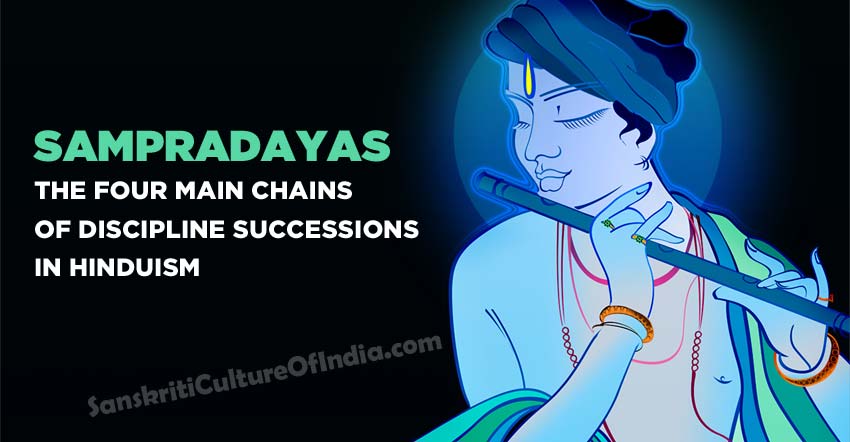There are four main sampradayas, or chains of discipline succession descending down through the important acharyas, or spiritual preceptors. These are also the main schools of thought in the Vedic tradition. Thus, anyone should belong or be a part of one of these sampradayas if they are going to be considered authorized in their Vedic teachings or practice. These sampradayas are the following:
- Sri sampradaya, where the main exponent is Ramanujacharya (who lived in 12th century, born in 1016), propagated the doctrine called visista advaita, or oneness with varieties of the Lord and His energies. This is said to have originated from Sri or Goddess Lakshmi.
- Brahma sampradaya, where the main exponent is Madhvacharya (who lived in 13th century, born in 1238), propagated the doctrine called visista dvaita, or duality with varieties. This is said to have originated from Lord Brahma.
- Rudra sampradaya, the main exponent is Vishnu Swami, who propagated the doctrine called suddha dvaita, or pure transcendental duality; Vallabha Acharya is also a branch of this sampradaya. This is said to have originated from Rudra or Lord Shiva.
- Hamsa, Catuhsana, Kumara or Sanat sampradaya, the main exponent is Nimbarka, who propagated the doctrine called dvaita advaita or simultaneous oneness and duality. This is said to have originated from Lord Brahma’s sons, the Kumaras of which Sanat Kumara is one.
Ramanuja
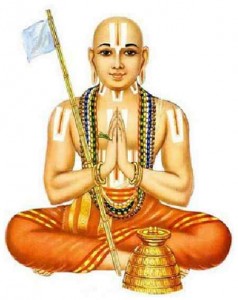 The main exponent of the Sri sampradaya, born in 1016 (some say in 1055), propagated the doctrine called visista-advaita, “oneness with varieties of the Lord and His energies”.
The main exponent of the Sri sampradaya, born in 1016 (some say in 1055), propagated the doctrine called visista-advaita, “oneness with varieties of the Lord and His energies”.
His school is probably the most famous in south India and has various branches, all characterized by a particular tilaka (a mark on the forehead made with sacred clay and natural colors).
Ramanuja was deeply influenced by the devotional poetry of the south Indian mystics known as Alvars, and resided as a pujari or priest in the temple of Ranganatha or Srirangam (near modern Tirucchirapalli).
This philosophy states that the jiva (the individual soul) and the jagat (the material universe) depend on Isvara (the Supreme sa-guna Brahman, or Bhagavan), the only Reality. According to this philosophy, the individual soul can be either baddha(conditioned) or mukta (liberated). Jagat, the material world, is real and eternal, although manifested and withdrawn in cycles, meaning it is temporary.
This philosophical system is based on pramana (“epistemology, or evidence”), explained as pratyaksa (direct perception), anumana (
God manifests in five forms as:
- Para (the transcendental form),
- Vyuha (the divine manifestations that originate Reality),
- Vibhava (the avataras),
- Archa (the Deity form) and
- Antaryami (residing in the heart of each living entity and each atom).
Ramanuja wrote Vedartha sangraha (on the Vedas), Sri bhasya (on Vedanta), Bhagavad Gita bhasya, Vedanta sara (a summary of Vedanta), Vedanta dipa (describing the subjects of Vedanta), Saranagati gadhya (prayers favoring surrender to Narayana), Sri Ranga gadhya (prayers in glorification of the holy city of Sri Ranga), Sri Vaikuntha gadhya (prayers glorifying Vaikuntha, the spiritual world), Nitya grantha (a manual for daily worship and rituals, including funeral and birth ceremonies).
Introductory works to his philosophy have been written by Srinivasa dasa (Yatindra mata dipika) and Bucchi Venkatacharya (Vedanta Karivadi).
He founded seventy-four centers of Sri Vaishnavism and initiated seven hundred sannyasis (renounced monks), twelve thousand brahmacharis (
Ramanuja is said to have visited Puri during the reign of Choda Ganga Deva. Tradition says that he tried to convince the priests of Jagannatha temple to stop the tantric style of puja they were following.
However, while he was sleeping in the night he was carried away to the bank of river Bhargavi by Garuda himself. He failed to introduce his worship system also in Trivandrum (the temple of Ananta Padmanabha), but he succeeded in Tirupati, substituting the texts known as the Vaikhanas agamas with the Pancaratra agamas. In Puri he founded the Emar Math.
Madhva
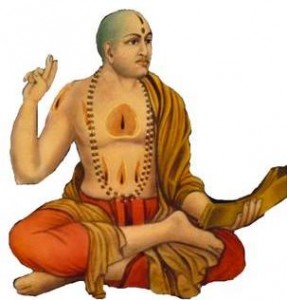 The main exponent of Brahma sampradaya, born in 1238 (some say in 1199), propagated the philosophy called Dvaita or Visistha Dvaita (“duality with differences”, or “different differences”). The center of the Madhva school is Udupi, the birthplace of Madhva.
The main exponent of Brahma sampradaya, born in 1238 (some say in 1199), propagated the philosophy called Dvaita or Visistha Dvaita (“duality with differences”, or “different differences”). The center of the Madhva school is Udupi, the birthplace of Madhva.
According to this philosophy, there is a substantial distinction between Isvara (God), jiva (individual soul) and jagat (material energy). Isvara is always independent (sva-tantra) while the jivas (souls), prakriti (
These five differences are eternal, although jagat can be sometimes manifest (vyakta) and sometimes not manifest (avyakta). Jivas are also eternally categorized in three groups as sattvik (who can attain mukti or liberation), rajasik (destined to remain in samsara or cycles of birth and death, but with the possibility of making progress) and tamasik (hopelessly destined to hell or darkness).
Another perspective on the various differences explained by Madhva is thesajatiya, vijatiya and svag
The collection of the 37 books written by Madhva (called sarva-mula) is divided in four groups:
- prasthana traya, including two commentaries on Bhagavad-Gita, ten onUpanishads, four on Vedanta sutras, and one on Rig Veda.
- dasa prakarana, ten short books explaining the points of Madhva’s doctrine; the most important is the Vishnu tattva vinirnaya, detailing the characteristics of theatman (individual soul) and establishing Vishnu’s supremacy.
- smriti prasthana, commentaries on Bhagavata Purana and Mahabharata.
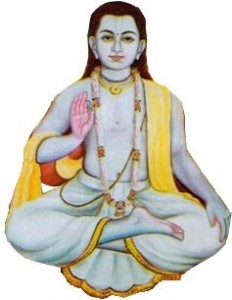 poems and essays about rituals and sannyasa (renounced order of life).
poems and essays about rituals and sannyasa (renounced order of life).
Nimbarka
The main exponent of the Kumara or Chatuhsana sampradaya (this knowledge was transmitted to the four Kumaras by the Hamsa avatara), who lived in the 13th century and propagated the doctrine called dvaita advaita, “simultaneous oneness and duality”.
Nimbarka presents himself as a disciple of Narada Muni and says that for a period of his life he lived in Naimisharanya.
This philosophical school has centers in the area of Mathura-Vrindavana (Nimbarka was born near Govardhana from a family of Telugu brahmanas), Rajasthan and Bengal, and identifies the Supreme Brahman as the divine couple of Radha and Krishna.
The identification between the savisesha (with form) and nirvisesha (without form) aspects of Bhagavan (the Supreme Person) is called svabhavika-bheda-abheda
His most famous works are the Vedanta Parijata Saurabha (commentary to the Vedas and Upanishads), Sada
Vishnuswami
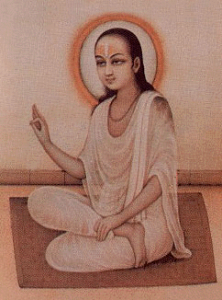 The fourth Vaishnava acharya, Vishnusvami, representative of the Rudrasampradaya (who worship the avatara of God known as Narasimhadeva) is less known than the other three.
The fourth Vaishnava acharya, Vishnusvami, representative of the Rudrasampradaya (who worship the avatara of God known as Narasimhadeva) is less known than the other three.
Actually there is some confusion about him, as it seems there have been three Vishnu Svamis: Adi Vishnu Svami (around 3rd century BCE, who introduced the traditional 108 categories of sannyasa), Raja Gopala Vishnu Svami (8th or 9th century CE), and Andhra Vishnu Svami (14th century).
The emphasis of this school, called suddha-advaita (“pure monism”), is on the concept of lila or the pastimes by which God can be transcendental and immanent according to His will. Thus everything is pure, including the material universe, that is created by God and intimately related to Him. In his method of worship, Vishnusvami gives preeminence to Rama, the previous avatara before Krishna.
Vishnusvami visited Puri and founded there the Jagannatha Vallabha Math in the gardens of the temple, where Ramananda Raya also established his spiritual school.
Among the famous followers of this sampradaya we can mention Sridhara Svami (who became famous for his commentary on the Bhagavata purana).
Vallabha Bhatta Acharya
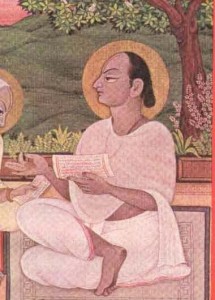 He appeared in 1479 in South India and disappeared in 1531. He detached himself from the tradition of Vishnusvami and started his own school, which is prominent today in Mathura-Vrindavana. In his school there are no sannyasis (renounced monks) but only householders.
He appeared in 1479 in South India and disappeared in 1531. He detached himself from the tradition of Vishnusvami and started his own school, which is prominent today in Mathura-Vrindavana. In his school there are no sannyasis (renounced monks) but only householders.
Vallabha traveled extensively in India to engage in philosophical debates. He wrote the Tattvartha dipa nibandha (divided in three parts, one about Bhagavad-Gita, one about Srimad-Bhagavatam, and the third a comparison between philosophies), Anubhasya (non completed commentary on Vedanta sutra), Purva mimamsa bhasya(commentary on Jaimini’s karma kanda philosophy), Subodhini (
For Vallabha, the realization of the Para Brahman, the complete (purna) aspect of the Brahman, can be achieved only through pushti (“nourishment”)
Vallabha Acharya probably came to Puri the first time in 1489 as a young boy, but returned in 1519 for his preaching. He was proud to be a great scholar and started a Bhakti Marga center in Varanasi. He contacted Lord Chaitanya in Prayaga (Allahabad) and was sent to debate with Advaita Acharya.
So he started to criticize the Sankirtana (congregational chanting of the Lord’s holy names) movement by objecting that, if the devotees were worshiping Lord Krishna in the madhurya rasa (mood of loving exchanges) they should not chant His name, as a faithful wife is not supposed to call her husband confidentially by his name, but always address him with a respectful title. Advaita Acharya quickly silenced him by saying “on His order, we are doing”. The point is that if the husband specifically requests the wife to call him intimately by his name, a faithful and loving wife should do so happily to please her husband. Similarly, Lord Krishna has ordered all of us to chant His name intimately, so as faithful wives and servants of the Lord, we should do so.
Another day, in the presence of Lord Chaitanya, Vallabha Bhatta boasted that his own commentaries were different from those of Sridhara Swami. Sri Chaitanya quickly rebuked him. It is said that in the end Vallabha Bhatta was convinced of the superiority of the teachings of Lord Chaitanya and from the worship of Bala Gopala was initiated into madhurya rasa by Gadadhara Pandita.
The son of Vallabha Bhatta, Vittala, adopted Gita Govinda as his text for teaching Sanskrit in his school.
The preaching of Vallabha Bhatta made the worship of Bala Gopala popular in all Hindu homes. His philosophy distinguished the two different roads in Vishnu worship as Maryada bhakti (or devotion in respect), where God is worshiped as the Supreme Brahman and Pusthi bhakti (or devotion in intimacy).
Sri Chaitanya Mahaprabhu
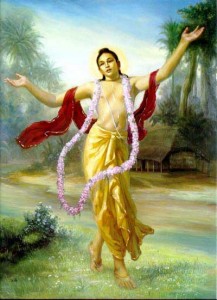 Sri Chaitanya Mahaprabhu (A.D. 1486-1534) also strongly opposed Shankara’s Mayavada philosophy of Dwaita and established the principle that took the previous acharya’s teachings to a new level, called achintya-bhedabheda-
Sri Chaitanya Mahaprabhu (A.D. 1486-1534) also strongly opposed Shankara’s Mayavada philosophy of Dwaita and established the principle that took the previous acharya’s teachings to a new level, called achintya-bhedabheda-
Sri Chaitanya taught that the direct meaning of the Vedic shastras is that the living entities are to engage in loving devotional service, bhakti, to the Supreme, Bhagavan Sri Krishna. Through this practice there can develop a level of communication between God and the individual by which God will lovingly reveal Himself to those who become qualified. In this understanding, the Vedic theistic philosophy of Vaishnavism reached its climax. Thus, Sri Chaitanya started what could be called a new philosophy that perfected the previously developed schools of thought, or united the basic principles of the other sampradayas.
Sri Chaitanya Mahaprabhu, who is considered and was established by Vedic scripture as the most recent incarnation of God, did not become much involved in writing. In fact, He only wrote eight verses called the Shikshastaka, but His followers compiled extensive Sanskrit literature that documented His life and fully explained His teachings. However, it is one of His followers, Baladeva Vidyabushana, who wrote a commentary on the Vedanta-sutras called Govi

